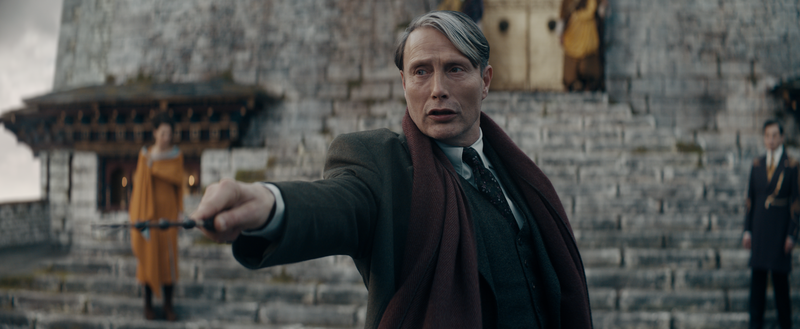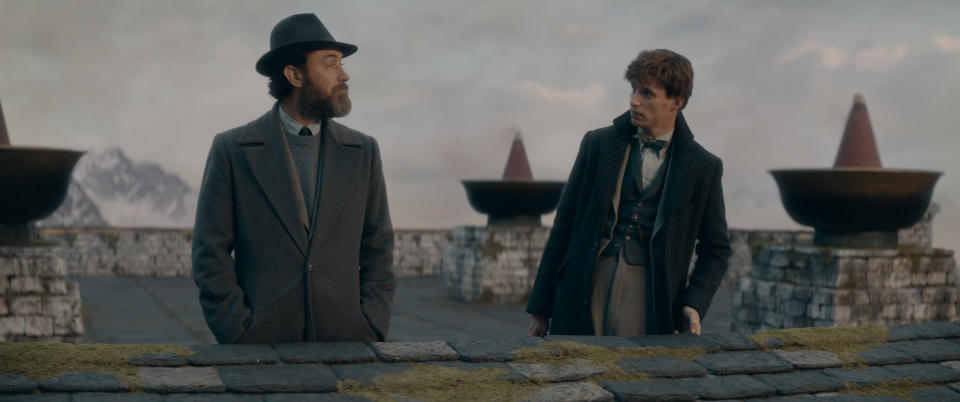‘Fantastic Beasts: The Secrets of Dumbledore’: How VR Benefited the ‘Harry Potter’ Spin-off

- Oops!Something went wrong.Please try again later.
- Oops!Something went wrong.Please try again later.
While virtual production has become a mainstay of “Fantastic Beasts,” the introduction of VR to the planning and designing of digital set builds was crucial to the series’ latest chapter — particularly when shooting was postponed by COVID-19 lockdown. This was due to the new pre-production services toolkit of London-based VFX studio Framestore, which handled “The Secrets of Dumbledore” and the two “Harry Potter” spin-offs that preceded.
Launched early in 2020, Framestore Pre-production Services (FPS) delivered 90 minutes of postvis for David Yates’ director’s cut, as well as using virtual production tools to help plan and visualize some of the film’s key set pieces, including the chaotic Berlin political rally, and the final battle in Bhutan between Dumbledore (Jude Law) and dark wizard Grindelwald (Mads Mikkelsen).
More from IndieWire
'Moon Knight': Visualizing Marvel's Mind-Bending Miniseries as a Battle Between the Two Oscar Isaacs
FPS utilizes virtual scouting and virtual cameras to interactively stage previs via fARsight, Framestore’s proprietary virtual production tool. fARsight uses a VR headset or an iPad, which connects to a PC running the Unreal game engine. One of its great benefits is supporting multiple users in a single session, especially when working remotely and in different parts of the globe.
For “Secrets of Dumbledore,” VFX production supervisor and Framestore creative director Christian Manz, FPS enabled closer collaboration with the film’s art department (led by production designer Stuart Craig and art director Neil Lamont) during pre-production. “We wanted to be able to visualize all of the worlds that would be built eventually and to be there to make sane decisions about that before anything was built,” Manz told IndieWire.
In the past, the art department builds have not always been VFX friendly, according to Manz, but by bringing them into fARsight, they could alleviate this deficiency by working together in VR space. They could additionally plan the camera moves with DP George Richmond and other crew, and also get director Yates’ input. This extended to decision making during shoots as well, when cast and crew could view how the digital sets would look on a monitor or iPad.

Warner Bros.
“This helped how to frame [shots] and how to populate it and move stuff around and make adjustments,” Manz added, “especially when COVID happened when we had to manage with 80 people for a large crowd scene [for the Berlin Ministry of Magic political rally]. That had a massive footprint of a set [at Warner Bros. Studios, Leavesden], but about 95 percent of it was digital [handled by Digital Domain]. So we had storyboards that we were working on with David [Yates], who I was able to spend an hour plotting camera to match those storyboards. It was important to get the sense of chaos that David wanted. We didn’t want to create digital people who were close up, but we could effectively paint in [a crowd of] 4,000 people. It enabled us to walk through that crowd and work out how many people we could see and begin to work out that we had a game plan before we turned up on the set that day.”
VR also came in handy for planning drone shots with a God’s eye view perspective, saving the production the time and expense of getting an actual drone in and waiting for the right weather conditions to figure out the shots that were needed. “Those camera moves we created were presented to the drone operators,” Manz said. “George Richmond bought into it every day on set, where, with an iPad, we could load up a scene and walk around freely and you’d be able to see the digital set there in camera and joined with what was real. And every time the actors walked by, they got used to seeing what they’d be looking at, and also all the supporting artists.”
For the final sequence, Grindelwald plots world domination as the wizarding leaders gather in 1932 at a monastery in Bhutan to elect the new Supreme Mugwump. The intent was to shoot the exterior scene outside. However, with rainy weather in London, they shot some of it in a sound stage, while the top section of the monastery set was an exterior build at Leavesden. Yet utilizing popular LED wall tech proved inappropriate here.

Warner Bros.
“We initially explored the LED panels but because we were putting in a landscape that would be far away and the sheer cost with a lot to shoot, it didn’t seem like the right tool,” Manz said. “But what we did do was wrap the whole stage in a graduated painted backing that approximated the rough colors of what would be put in there eventually. It was sky blue on one side to represent the landscape and a warmer color on the other to represent where the sun would be, and then the stage was covered in silk, and there were about 300 sky panels above that. It worked out well because we got the right bounce light match [along with everything else].”
The final battle between Dumbledore and Grindelwald (with VFX by Digital Domain) leans into an ethereal dreamscape look, and greatly benefited from fARsight’s VR planning capability. “We shot all of that action on the same set, but George changed the lighting so it was a lot brighter and had a lot more fill and a lot less shadow to give Jude and Mads a different look,” said Manz. “We worked out the choreography with the stunt team and actors using previs and stunt vis.
“The world around them is fracturing, and we were trying to link up the flip into the dark world in Berlin,” he added. “We then added that the cafe at the beginning [with Dumbledore and Grindelwald] would melt into the ethereal white world as well, so it all [connected] to the idea of questioning reality. Then we went back to previous ‘Potter’ films and the molten feel of their spells. But what we wanted to bring to this was that there were these two adults fighting close together and that quick, intense combat stuff. It’s a tease for that big battle between the two of them that eventually takes place in 1945.”
Best of IndieWire
Sign up for Indiewire's Newsletter. For the latest news, follow us on Facebook, Twitter, and Instagram.


